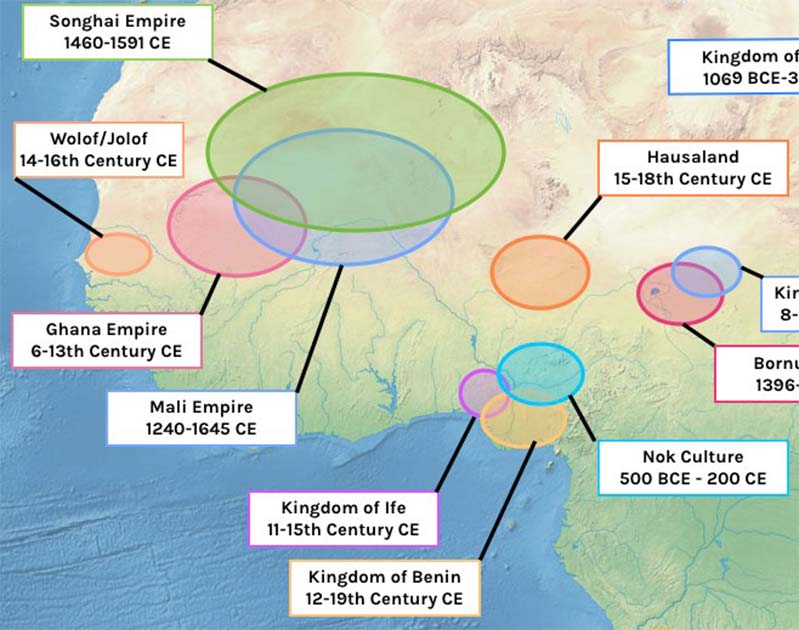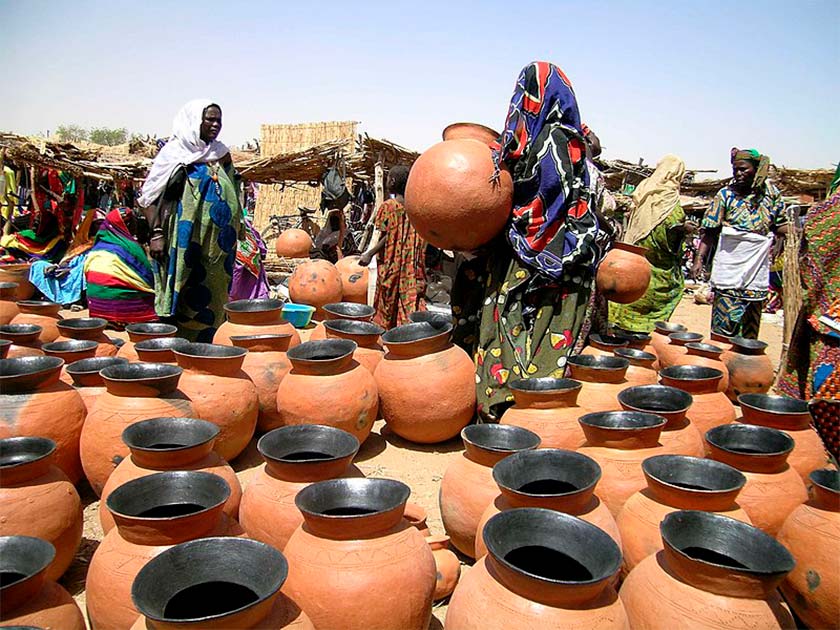The Songhai Empire was a great trading state found in West Africa that flourished between the 15th and 16th centuries. It was centered on the Niger River near where present Mali is today.
It extended all the way to the Atlantic coast and into Niger and Nigeria. Its capital was Gao, which is now a small trading town on the Niger River and was home to the Tomb of Askia and the Gao Mosque.
It was founded around 800 AD but did not hit a peak until the 15th century. It grew so prosperous that it attracted the interest of the neighboring Mali Empire and was conquered by it in the 14th century.
But this would not last. Here is the story of the Songhai.
Pre-imperial Songhai
The Songhai people began as a smaller kingdom that ran alongside the eastern side of the Niger River. However, in the reign of King Sunni Ali (reigning 1464-1492), their territory expanded greatly.
Before this, several different groups of people would be formed into the Songhai people. The first people to settle in the region of Gao were the people known as the Sorko. The Sorko fashioned boats and canoes from local trees and used these for fishing and hunting. The Gao people joined them in this area and specialized in hunting animals that lived in the river such as the hippopotamus and the crocodile.
Another group of people would soon join them, and they were known as the Do people. However, they were more agriculturally inclined and raised crops in fertile lands around the river.

Before the 10th century, all of these peoples were assimilated into one nation by a powerful group that rode on horseback and spoke Songhai. They established control and began to incorporate other people.
- Abu Bakr II: Did the King of Ancient Mali go to America?
- Mysterious and Massive: Who Built the Walls of Benin?
The earliest dynasties of the Songhai people are obscured in history. Most of the information comes from an ancient cemetery found near Saney which is close to Gao. Some of the inscriptions indicate that the ruling dynasty was established before the 11th and 12th centuries. They all seem to have borne the name “Malik” which is king in Arabic.
These forgotten kings were rich, however. Evidence of luxuries such as gold, salt, slaves, dates, leather, ivory, and kola nuts have been associated with the early Songhai. Due to the popularity of these trade goods, Gao soon became very prosperous and thus attracted the attention of the nearby and powerful Mali Empire.
Unfortunately, Gao was conquered by the Mali Empire and all of the financial gains were redirected to Mali. This lasted until around the 1430s. However, troubles in Mali made it difficult to maintain control of Gao.
Freedom from Mali
In the 1360s, the ruler of Mali, Mansa Sulayman died. This led to political instability and succession disputes. The empire was weakened as it fell into turmoil and internal disputes.
Mari Djarta II was appointed as ruler but he was an ineffective king that led the empire into terrible financial troubles. Remarkably, the large empire managed to stay together and was passed to Musa II. Rebellions however began to spring forth which allowed the Songhai people to liberate Gao.
One influential leader in the Songhai people, Sunni Ali, was able to properly establish the Songhai empire in the late 15th century. He worked hard to fully liberate Gao from Mali, made possible by the political insurrection in the Mali Empire.
He aided other local peoples and help to rid them of the Mali invaders. Ali managed to drive them out of kingdoms such as Timbuktu and liberated/took control of most of the trading cities along the Niger River.
Sunni Ali conquered many of the region’s neighboring states and much of the Mali Empire. He has been considered the Songhai Empire’s most formidable military leader and strategist.
- Africa’s Strange Ruin: What Exactly Is Great Zimbabwe?
- Who Built the Abandoned City of Djado? A Saharan Mystery
Ali conquered any lands and repelled attacks from the Mossi and Dogon People. He annexed Timbuktu in 1468 and after a seven-year siege, he added Djenne. This was an incredibly prosperous trading town.
However, Ali was not known as a benevolent ruler. He has been described as an intolerant tyrant by many Muslim writers due to his despicable behavior toward the citizens of Timbuktu. He followed a repressive policy against the writers of Timbuktu and slaughtered many of them. It must be conceded though that he brought great wealth to the Songhai Empire.

Ali was succeeded by a ruler that became known as Askia the Great. Askia furthered the boundaries of the empire to the South and the East, and he created a full-time army for the Songhai Empire. Not only this, but Askia also pursued more peaceful policies such as seeking alliances and opening religious schools.
He even took a hajj to Mecca and donated vast sums of money to impress the people of Mecca. Along the way, he recruited Muslim Scholars from Egypt to teach at his new schools. However, it was not to last.
Decline
As Askia grew older his power declined. In 1528, he faced a revolt from his own sons which was successful. Unfortunately, like a mirror to the Mali Empire, this led to political unrest. Musa, who had overthrown his father, lasted only 3 years before being overthrown in 1531.
There were multiple attempts to overthrow the rulers and the empire began to decline. What did not help was the Saadian invasion of the Songhai Empire. They hailed from Morocco and hoped to seize control of the trade of salt and gold.
Despite the professional armies of the Songhai empire, they were never modernized like the armies of Morocco, who brought with them cannons and arquebusiers. In 1591, the Battle of Tondibi was decisive and the Moroccans destroyed the entire Songhai army before marching to capture Goa and Timbuktu.
It was a short-lived empire but one that managed to spread quite significantly across Western Africa. However, political turmoil, civil wars, and a lack of technology would ultimately bring the downfall of the empire and it would never rise to such heights again.
Top Image: The Tomb of Askia, perhaps the most successful ruler of the Songhai Empire. Source: Taguelmoust / CC BY-SA 3.0.
By Kurt Readman